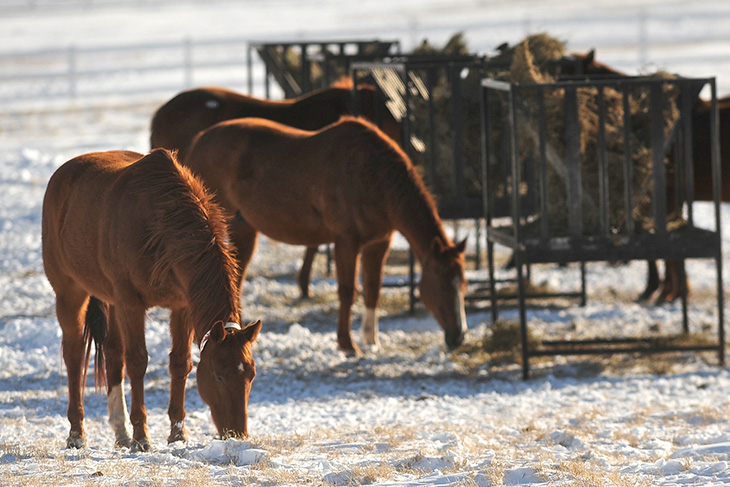
Horse owners need to be watchful for signs of colic
Friday, February 12, 2021
Horse owners need to take steps to ensure colic does not become a problem for their animals as temperatures drop, said Oklahoma State University experts.
“Horses need more feed to replace energy loss brought about by harsher wintertime weather conditions,” said Kris Hiney, OSU Extension equine specialist with the university’s Department of Animal and Food Sciences. “A good first step is to maximize forage intake. Give them as much hay as they will eat during cold weather.”
Concentrate composition and amounts should be increased gradually over a period of several days, especially if the horses are already consuming large quantities of grain. Horses may suffer from colic if ration changes occur too rapidly.
Many concentrates or grain mixes will have significant levels of soluble carbohydrates, which are efficient providers of energy. However, eating too much of these compounds in one meal is a significant contributor to the frequency of colic and founder in horses.
One general guideline is to limit grain feedings to maximum, single, meal intakes of around 5 pounds per 1,000 pounds of body weight, Hiney said. However, some concentrates are less energy-dense than others, so horse managers should follow recommended intake levels on feed bags.
In addition to abrupt changes in diet and overfeeding energy, nutritional causes of colic include consumption of moldy grain or hay and improper digestion and impaction of nutrients brought on by ineffective deworming programs.
A horse's anatomy makes the animal more susceptible to colic, an acute abdominal pain caused by various abnormal conditions. A horse has about 100 feet of intestines, most of which floats free in the abdomen. This free flotation makes it easy for the intestines to become tangled or displaced.
Symptoms of colic in a horse may include:
- Depression.
- Lack of interest in eating.
- General restlessness such as pawing at the ground.
- Looking at its sides constantly.
- Lying down more than is typical for the animal or at unusual times.
- Lying down, getting up, circling and then lying down again, repeatedly.
- Curling or lifting of the upper lip.
- Kicking up at the abdomen with its hind legs.
- Violent rolling.
“When it comes to lack of interest in eating, be sure the horses drink plenty of water as decreased fluid intake also can lead to colic,” Hiney said. “Horses tend to consume less water when temperatures drop. Also, make sure water sources are not frozen and that horses have ready access at all times.”
Additional OSU Extension recommendations for cold-weather management include adding insulation around tanks, using heaters and making plans to haul water if hydrants freeze. Equine managers may want to use sealed containers to haul water.
Since colic can occur from many different causes, equine managers who observe signs of colic in a horse should remove all feed, hay and water, and then call their local veterinarian immediately, said Dr. Rosslyn Biggs, OSU Extension veterinarian and director of continuing education for the university’s College of Veterinary Medicine.
“Knowing how to measure a horse's respiration rate, heart rate and temperature and then relaying this information to the attending veterinarian will help in the initial diagnosis or treatment,” Biggs said. “Horses that will lie quietly can be allowed to do so, but colic-suffering horses should not be allowed to roll.”
Fact sheets detailing research-based information about equine colic and feed management are available online and through OSU Extension county offices.
MEDIA CONTACT: Donald Stotts | Agricultural Communications Services | 405-744-4079 | donald.stotts@okstate.edu
